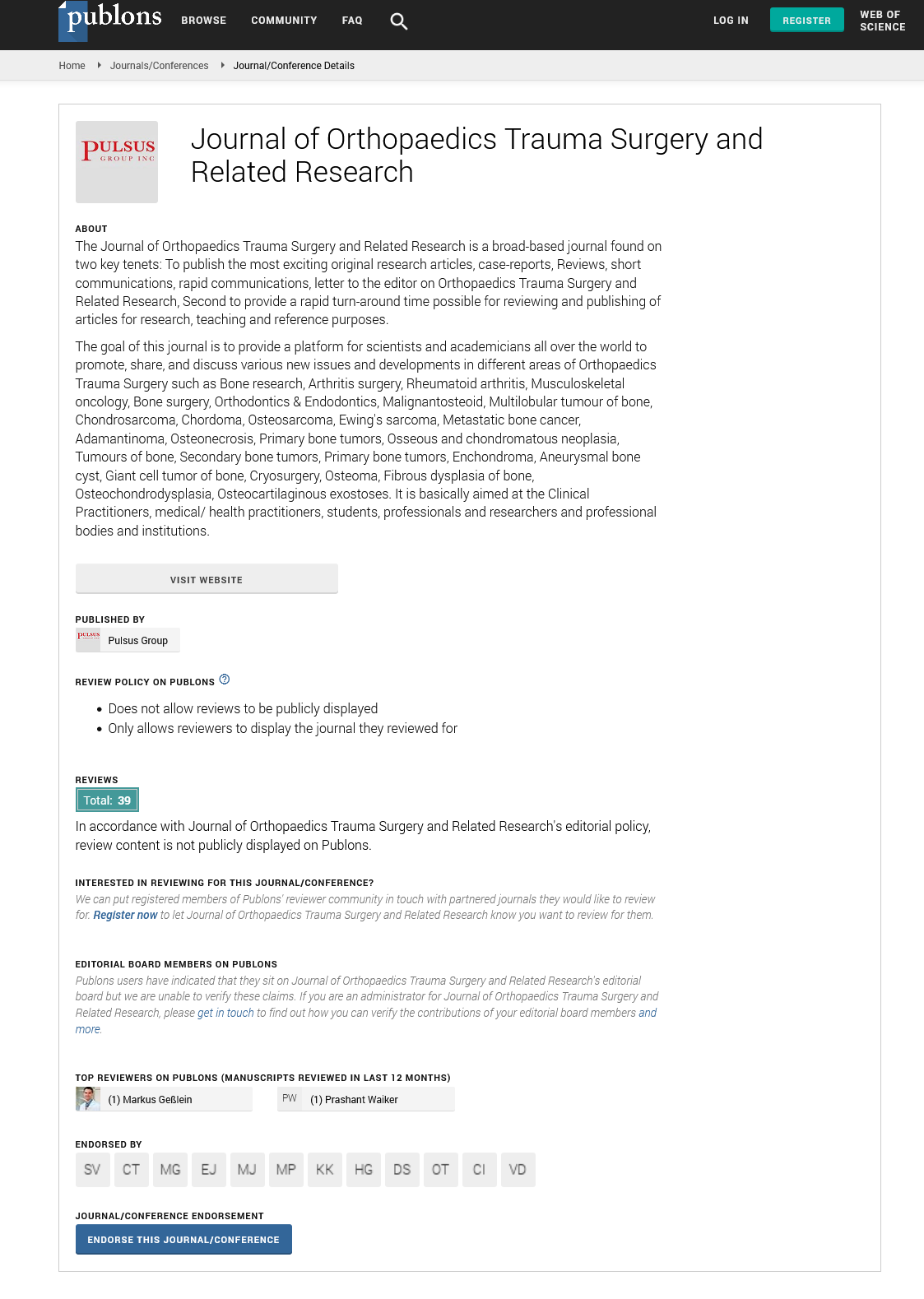Bone Marrow Edema Syndrome
Received: 12-Nov-2021 Accepted Date: Nov 18, 2021 ; Published: 23-Nov-2021, DOI: 10.37532/1897-2276.2021.16(1).52
This open-access article is distributed under the terms of the Creative Commons Attribution Non-Commercial License (CC BY-NC) (http://creativecommons.org/licenses/by-nc/4.0/), which permits reuse, distribution and reproduction of the article, provided that the original work is properly cited and the reuse is restricted to noncommercial purposes. For commercial reuse, contact reprints@pulsus.com
Abstract
BMES (Bone Marrow Edema Syndrome) is a self-limiting illness that affects young and middle-aged women and men. It is characterised by a sudden onset of pain in the affected area. Extracorporeal Shock Wave Therapy (ESWT) has been used to treat a variety of orthopaedic disorders, including avascular necrosis, and because to the positive results, it was tried on patients with BMES as a non-operative treatment option.
https://linktr.ee/marmaris1 https://www.divephotoguide.com/user/marmaris1/ https://artmight.com/user/profile/2408931 https://allmyfaves.com/marmaris1 https://www.fimfiction.net/user/628252/marmaris https://www.drupalgovcon.org/user/568666 https://www.roleplaygateway.com/member/marmaris1/ https://www.kickstarter.com/profile/825997479/about https://tapas.io/sam659667 https://seedandspark.com/user/marmaris1 https://starity.hu/profil/386591-marmaris1/ https://www.informationweek.com/profile.asp https://nootheme.com/forums/users/marmaris1/ https://app.roll20.net/users/12308972/marmaris1-m https://www.360cities.net/profile/sam659667 https://fileforum.com/profile/marmaris1 https://wordpress.org/support/users/marmaris1/ https://www.hebergementweb.org/members/marmaris1.539143/ https://forum.cs-cart.com/u/marmaris1/ https://www.tntxtruck.com/User-Profile/UserId/12208 https://calis.delfi.lv/blogs/posts/205779-linkler/lietotajs/310821-marmaris1/ https://profile.ameba.jp/ameba/marmaris1/ https://www.avianwaves.com/User-Profile/userId/184770 https://engine.eatsleepride.com/rider/marmaris1 https://keymander.iogear.com/profile/53051/marmaris1 https://www.mifare.net/support/forum/users/marmaris1/ https://inkbunny.net/marmaris1?&success=Profile+settings+saved. https://www.diggerslist.com/64e0c4fad170b/about https://research.openhumans.org/member/me/ http://bluerevolutioncrowdfunding.crowdfundhq.com/users/marmaris1 https://www.cakeresume.com/me/marmaris1 https://educatorpages.com/site/marrmaris1/pages/about-me? https://gotartwork.com/Profile/marmaris1-marmaris1/253385/ https://www.facer.io/user/OGfo7VWrhR https://able2know.org/user/marmaris1/ https://www.techrum.vn/members/marmaris1.230749/#about http://foxsheets.statfoxsports.com/UserProfile/tabid/57/userId/145739/Default.aspx http://riosabeloco.com/User-Profile/userId/196075 http://phillipsservices.net/UserProfile/tabid/43/userId/245691/Default.aspx http://www.ramsa.ma/UserProfile/tabid/42/userId/962725/Default.aspx http://krachelart.com/UserProfile/tabid/43/userId/1242308/Default.aspx http://kedcorp.org/UserProfile/tabid/42/userId/72907/Default.aspx http://atlantabackflowtesting.com/UserProfile/tabid/43/userId/561626/Default.aspx https://www.intensedebate.com/people/marmaris12 https://rosalind.info/users/marmaris1/ https://wordpress.com/me https://photozou.jp/user/top/3342211
Introduction
Bone Marrow Edema is a radiological term that describes a region of increased signal intensity on T2 sequences and decreased signal intensity on T1 sequences on Magnetic Resonance Imaging as a result of excessive water accumulation in the bone marrow caused by a variety of illnesses. Only MRI and, in a few cases, plain radiographs or computed tomography may reveal the BME pattern, which appears as a focused area of osteoporosis. Wilson was the first to use the term BME to characterize people with knee/hip pain and since then, other research have been published using the phrase. BME can occur in a variety of clinical circumstances and is classified into three groups based on the cause: ischemic (avascular necrosis, bone marrow edema syndrome), mechanical (bone contusion or bruise, stress injuries), and reactive (osteoarthritis, tumor-related conditions).
Transient Osteoporosis, transient bone marrow edema syndrome, bone marrow edema-like lesions, regional migratory osteoporosis, and reflex sympathetic dystrophy are all terminology used in the literature to represent a benign entity defined by transient BME pattern on MRI sequences. The treatment is largely conservative, with certain operational procedures like as core decompression or subchondroplasty thrown in for good measure. The purpose of this small review paper was to describe BMES and to go over some of the recent research that have been done on the use of Extracorporeal Shock Wave Therapy (ESWT) as a non-invasive treatment for BMES patients.
When the lower limbs are implicated, patients present with symptomatology of limited joint motion and rapid onset discomfort, which is aggravated by weight-bearing. The severity of the pain can range from minor to devastating, requiring hospitalization. Idiopathic is misdiagnosed in the majority of cases. Traditionally, the pain worsens for 2 months before subsiding 3-9 months after commencement, with the chance of recurrence in another or the same joint. Joint effusion may be present, as well as subcutaneous edema, increased sensitivity on touch and percussion compared to the contralateral joint, and the absence of neuromuscular atrophy. BMES should be distinguished from Avascular Necrosis (AVN), which can be detected with an MRI. The radiological findings in the early stages of BMES are virtually same, albeit localised abnormalities, double line sign, and subchondral signal alterations are pathognomonic of AVN.
ESWT is a non-invasive treatment that has been utilized in BMES off label with promising results, since it appears to offer immediate pain relief and functional improvement. As a result, it could be a possible safe non-invasive regimen for the rapid recovery of BMES in the knee or hip joint. ESWT has been successfully used to treat patients suffering from BMES in currently published studies, with statistically significant superiority in clinical and radiological outcomes (faster recovery/ remission of symptoms, faster resolution of BME on MRI, better and faster functional improvement) when compared to the control group. In one study, it was found to be superior to core decompression in all of the aforementioned characteristics.



 Journal of Orthopaedics Trauma Surgery and Related Research a publication of Polish Society, is a peer-reviewed online journal with quaterly print on demand compilation of issues published.
Journal of Orthopaedics Trauma Surgery and Related Research a publication of Polish Society, is a peer-reviewed online journal with quaterly print on demand compilation of issues published.